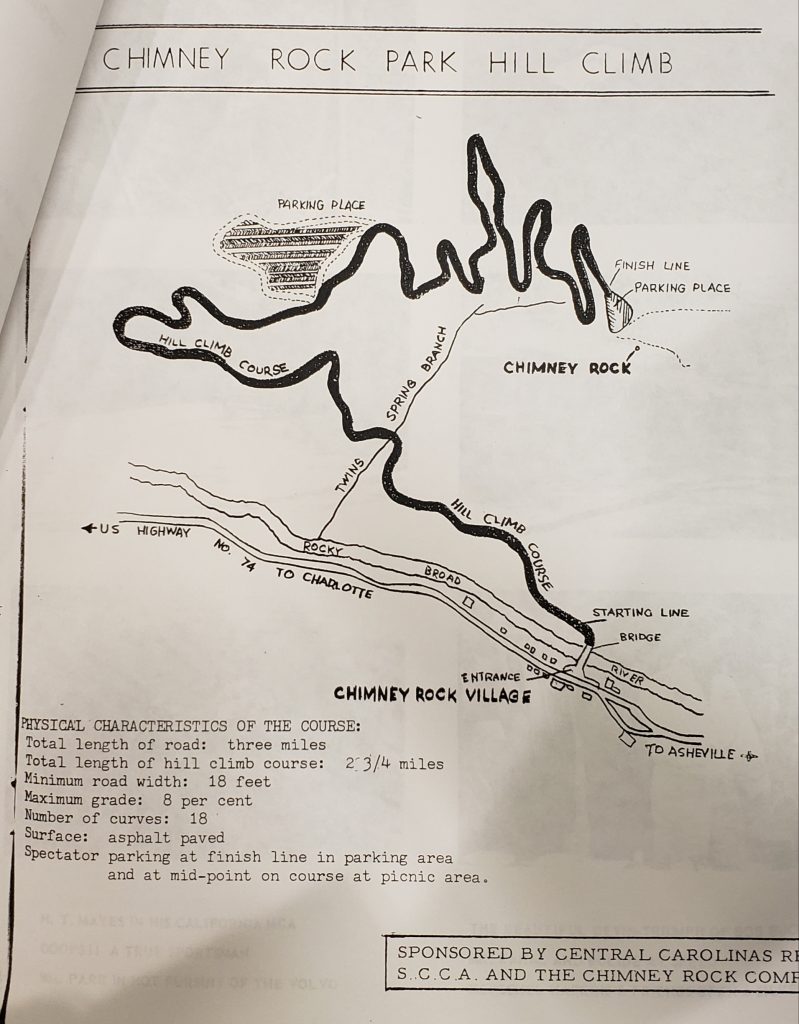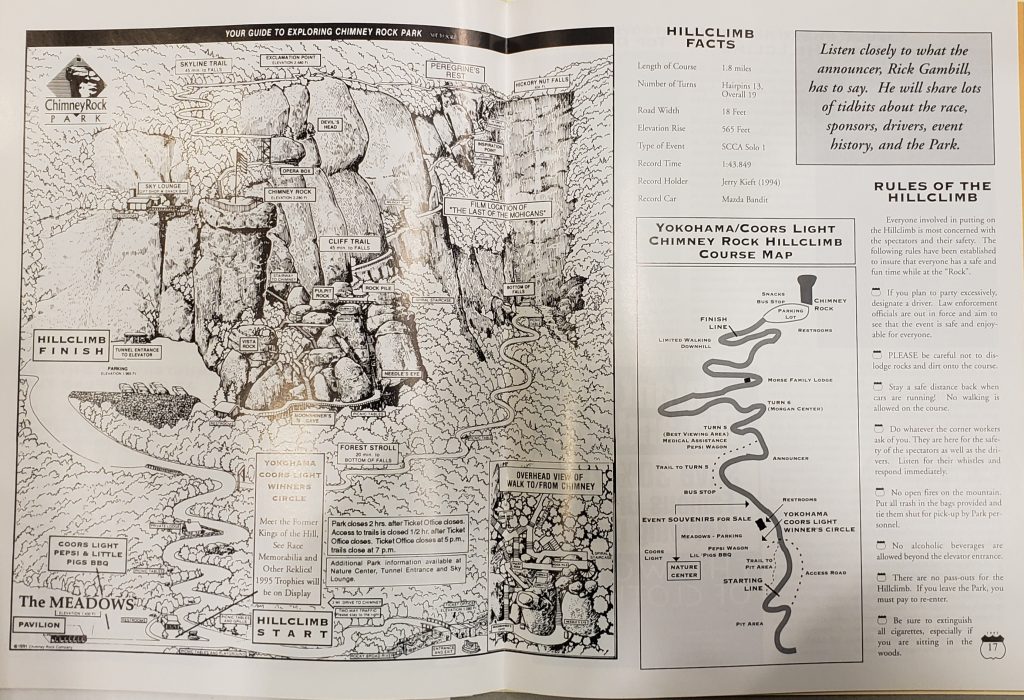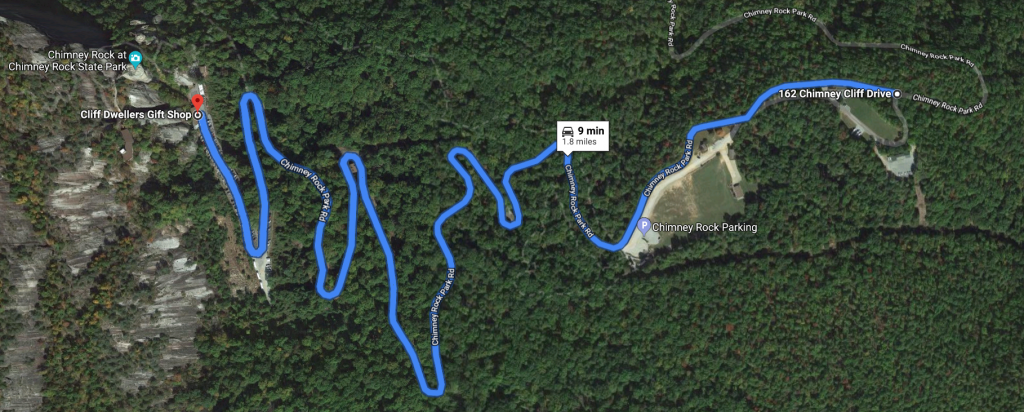Started by the Sports Car Club of America in conjunction with Chimney Rock Park, the Chimney Rock Hill Climb quickly rose to become the event of the year for amateur and professional racers in the Appalachian region.1 Crowds would form all along the track and especially inside the corners drivers had to navigate, cheering on the cars as they flew by. Remarkable, the hill climb remained a relatively safe event, with no serious injuries or catastrophic accidents.
As the hill climb became popular with racers and fans in the 1960s and 70s, Chimney Rock Park received more and more complaints from other visitors. 1995 was the 50th and final running, as at that point “the idea of preserving nature and auto racing didn’t really seem like compatible business objectives.”2 The race popularity started to slump in the late 1980s and early 1990s while overall park popularity grew, especially due to the Last of the Mohicans filming in 1992 and 1993. During the race, people visiting to see the beauty of the part itself were angry “because [staff] would have to shut the road down for the event and they’d only be able to open it periodically as there were breaks in the race. And then even so there were only limited spaces at the top parking lot because of the race cars being up there.”3 If only there was “another road to the top maybe we could have kept running it,” continuing the 30 year tradition into the 21st century and preserving one of the three biggest hill climb races in the country.4

The initial course: As the longest length course, this version only lasted for the first 4 years of the hill climb. Starting at what is now the main entrance to the park, this 2.7 mile route snaked up the mountain before finishing at a parking lot near Chimney Rock itself. The route was fully paved and was always at least 18 feet wide, or about 1.5 times the width of a standard US interstate highway lane today. The route had 18 sharp curves and hairpin turns, with the most difficult turns in the last third of the race.5
The second course: Starting in 1960, the route was shortened by almost a mile to a total of 1.9 miles in length, cutting out much of the beginning of the route and leaving the more difficult hairpin turns for drivers to negotiate. A mandatory stopping point in the middle of the race was removed in the 1960 route, much to the appreciation of the drivers. Having to fully stop and start again is uncommon in hill climb races and takes away from part of the driving experience and challenge. The new route had fewer sharp and hairpin turns, only 13.6

The final course: The third and final course was also the longest lasting course. For the 1976 season minor changes were made from the 1960 route, shortening the length of the hill climb to 1.8 miles. Despite the shorter length, no corners were removed, as this course was made to increase safety rather than to change the course itself. This was the longest-lasting version, with drivers honing in their abilities for almost 20 years along the 1.8 mile course.7


When the race began in 1956 with the longer course, finish times were all above the 4 minute mark. A shorter run and 40 years of technological improvements led to times below the 2 minute mark. The fastest time from three races is not known.
Notes: & denotes a wet road surface. Spring races are formatted as Year.1, with fall races formatted as Year.2.
Graph produced from data in the Morse Family Chimney Rock Park Collection, D.H. Ramsey Library, Special Collections, University of North Carolina Asheville.
Below is an example of the cars that raced up Chimney Rock while the hill climb was running. Cars varied from purpose-built hill climb racers, to sports cars, to largely unmodified street cars in the later years.
Several videos of the Hill Climb exist, recorded by drivers, fans, and the media. Visit the links below to some of these videos:
Chimney Rock Hill Climb, 1960, published by user Doug Carlisle
CHIMNEY ROCK HILLCLIMB NC, 1983, published by user Bill Austin
1984 Chimney Rock Hillclimb, 1984, published by user ageci1
Chimney Rock (NC) Hillclimb, circa 1990, published by user oldSCCAguy yah
Chimney Rock Hillclimb, 1995, published by user scargo7
Image Citations:
- Brato. 1957 Lotus XI at Le Mans Classic. Wikimedia.org. https://commons.wikimedia.org/wiki/File:1957_Lotus_XI_le_mans_classic_2008.jpg
- Morse Family Chimney Rock Park collection, D.H. Ramsey Library, Special Collections, University of North Carolina Asheville.
- Prevot, A. Replica Porsche 356 Speedster in Nancy, France. 2013. Wikimedia.org.
https://commons.wikimedia.org/wiki/File:Porsche_356_Speedster_-_Flickr_-_Alexandre_Pr%C3%A9vot_(6).jpg - Robotriot. Porsche 356 S90. 2009. Wikimedia.org.
https://commons.wikimedia.org/wiki/File:Porsche_356_S90_Front.jpg - Stahlkocher. Shelby AC 427 Cobra. Wikimedia.org.
https://commons.wikimedia.org/wiki/File:Shelby_AC_427_Cobra_vl_blue.jpg - Terabass. Porsche 904. Wikimedia.org.
https://commons.wikimedia.org/wiki/File:Porsche_904-terabass.jpg
- Chimney Rock Hill Climb 1956 to 1995, Morse Family Chimney Rock Park, D.H. Ramsey Library, Special Collections, University of North Carolina at Asheville
- Todd Morse, Interview by Christian Roughton, March 27, 2019.
- Todd Morse, Interview by Christian Roughton, March 27, 2019.
- Todd Morse, Interview by Christian Roughton, March 27, 2019.
- Brian Sullivan, “King of the Hill.” Our State, May 2008. http://digital.ncdcr.gov/cdm/compoundobject/collection/p16062coll18/id/99313/rec/2
- Brian Sullivan, “ King of the Hill.” Our State, May 2008.
http://digital.ncdcr.gov/cdm/compoundobject/collection/p16062coll18/id/99313/rec/2 - Brian Sullivan, “King of the Hill.” Our State, May 2008. http://digital.ncdcr.gov/cdm/compoundobject/collection/p16062coll18/id/99313/rec/2